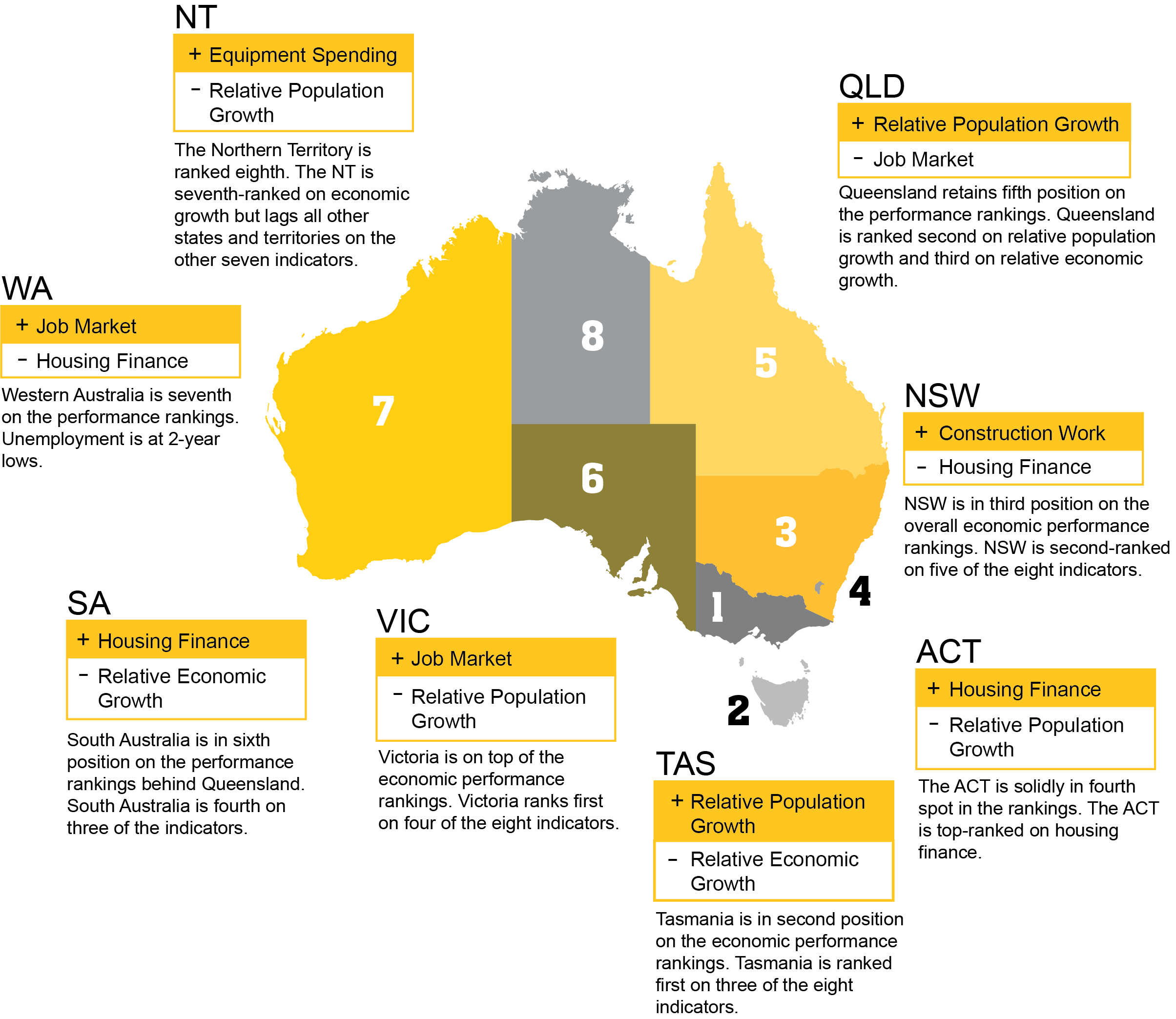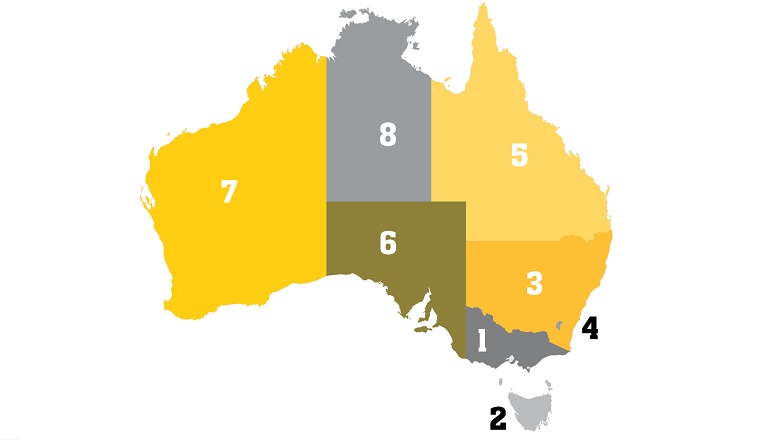Victoria remains Australia’s best-performing economy, leading the overall economic performance rankings, but Tasmania has lifted into second spot according to the latest CommSec State of the States report.
In the latest economic performance report, Tasmania has edged up in the performance rankings, overtaking NSW into second position. Tasmania is ranked first on relative population growth, dwelling starts and equipment investment and is in second spot on housing finance.
Victoria continues to lead the nation, ranking first on four of the eight economic indicators. The State continues to lead the nation on relative economic growth; retail trade; the job market; and, construction work done.
CommSec Chief Economist Craig James said: “Strong population growth continues to buoy Tasmania’s economy and has helped lift the state into the second spot overall. While NSW is now in third position the reality is that there is very little to separate these two economies with NSW consistently strong across all indicators.”
Below the top three, the ACT is in fourth spot, supported by a strong job market and solid demand for homes. Queensland and South Australia remain in fifth and sixth spot respectively with both states contending with relatively high jobless rates. Western Australia remains in seventh position, ahead of Northern Territory.
“Overall the underlying signs for the economy are positive. All States and Territories continue to see double digit economic growth over the long term average against a backdrop of a global slowdown and continued US-China tensions,” Mr James said.
When looking across growth rates for the states and territories, Victoria exceeded the national-average on seven of the eight indicators from ACT (six), Western Australia (four); and Queensland and Tasmania (three). At the other end of the scale, Northern Territory underperformed national results on all but one indicator. NSW and South Australia out-performed the national growth rate on two indicators.

Findings in detail:
1. Victoria
For the sixth consecutive quarter Victoria has remained Australia’s best-performing economy. Over the quarter, Victoria was unchanged in its rankings for all eight indicators and maintains top spot for economic growth with economic activity in the June quarter 26.6 per cent above decade average levels.
“Victoria remains unchanged as Australia’s best-performing economy and currently ranks first on four of the economic indicators, including economic growth, retail trade, unemployment rate, and construction work done. The State continues to benefit from strong population growth and a solid job market,” Mr James said.
2. Tasmania
Tasmania has continued to edge up in the performance rankings and is now solely in second spot based on strong population growth. Tasmania is ranked first in relative population growth, dwelling starts and business investment and is now ranked second for housing finance. Tasmania is also the strongest on new vehicle sales, up 8.4 per cent on decade averages.
“The Apple Isle has crept past NSW to now rank second in CommSec’s State of the States. Tasmania’s population growth is now double the state’s long term average and this is driving strong business investment and dwelling starts. These are positive signs for Australia’s island state with economic activity 19.3 per cent above decade average levels,” Mr James said.
3. New South Wales
NSW continues to be consistently strong across all indicators but has lost one place in the overall economic performance rankings to third, behind Tasmania. However, there is very little to separate the two economies on the overall rankings.
“Despite dropping to third place, NSW remains ranked second on five of the eight indicators. State economic activity remains strong with output 24.7 per cent above the ‘normal’ level of output. While NSW fell one spot each on population growth and dwelling starts, strong employment, construction and home building sectors continue to buoy the state,” Mr James said.
4. Australian Capital Territory
The ACT remains in fourth spot on the economic performance rankings, supported by a strong job market and solid demand for homes. The ACT is now in top spot for housing finance with the number of commitments up by 17.0 per cent on the long-term average.
“The ACT is solidly in fourth spot on the rankings. The ACT is now ranked first on housing finance and second on equipment investment and leads the nation with the strongest annual employment rate, up 3.3 per cent,” Mr James said.
5. Queensland
Queensland remains in fifth position on the economic performance rankings. Queensland is third ranked on relative economic growth, up 21.1 per cent above normal and ranked third on relative population growth, up 5.2 per cent on decade averages. However, Queensland remains fifth or sixth on most of the other indicators.
“Queensland has continued to show signs of improvement and has retained its in fifth position in the performance rakings. The state is second ranked on relative population growth and third ranked on relative economic growth. But Queensland is fifth or sixth on most of the other indicators,” Mr James said.
6. South Australia
South Australia remains in sixth position. But, as has been the case for the past 21 months, there is little to separate Queensland and South Australia.
“South Australia remains in sixth position in the rankings. Although losing two positions on economic growth and one position on dwelling starts, South Australia gained one position on each of population growth, unemployment and construction work. In terms of annual comparisons, South Australian housing finance commitments were down the least, by just 3.2 percent over the year,” Mr James said.
7. Western Australia
Western Australia retains seventh spot on the economic performance rankings and remains ranked seventh on six of the indicators. However, there are positive signs for the economy with the state’s annual population growth of 1.0 per cent the fastest rate in four years and equipment investment is at four and a half-year highs.
“Western Australia stays in seventh spot but the State is starting to narrow the gap with Queensland and South Australia. Western Australia has lifted two spots on economic growth and lifted one spot on unemployment,” Mr James said.
8. Northern Territory
The Northern Territory remains in eighth position. The Northern Territory is seventh-ranked on economic growth but lags all other states and territories on the other seven indicators.
“The Northern Territory remains in eighth position. There were no changes in relative rankings on the eight indicators. But encouragingly the Northern Territory is experiencing a lift in equipment spending from a low base. It does continue to underperform the national results on all but one indicator, economic growth.
About the State of the States Report
CommSec, the online broking arm of Australia’s largest bank, assesses the performance of each state and territory on a quarterly basis using eight key indicators. Those indicators include:
- economic growth,
- retail spending,
- equipment investment,
- unemployment,
- construction work done,
- population growth,
- housing finance, and
- dwelling commencements.
Just as the Reserve Bank uses long-term averages to determine the level of "normal" interest rates, CommSec compares the key indicators to decade averages, that is, against "normal" performance. CommSec also compares annual growth rates for eight key indicators for all states and territories, in addition to Australia as a whole, enabling a comparison of economic momentum.



